

Gigantic radio-emitting bubbles discovered at the center of our galaxy. Almost 900 asteroids are 'at risk of hitting Earth' in the next 100 years. Almost 900 asteroids are 'at risk of hitting Earth' in the next 100 years, European Space Agency warns as one is set to whizz past this week European Space Agency is meeting with several partners in Europe this week They will be discussing how to protect the Earth from asteroids that could hit itHowever unlikely, ESA says 878 asteroids could hit the Earth within 100 years By Danyal Hussain For Mailonline Published: 06:34 EDT, 11 September 2019 | Updated: 09:48 EDT, 11 September 2019 There are currently 878 asteroids at risk of hitting the Earth in the next 100 years, according to the European Space Agency (ESA).
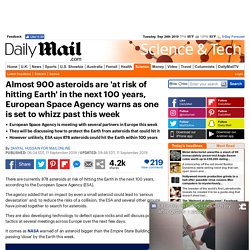
The agency added that an impact by even a small asteroid could lead to 'serious devastation' and, to reduce the risks of a collision, the ESA and several other groups have joined together to search for asteroids. They are also developing technology to deflect space rocks and will discuss potential tactics at several meetings across Europe over the next few days. Black hole at the center of our galaxy appears to be getting hungrier. The enormous black hole at the center of our galaxy is having an unusually large meal of interstellar gas and dust, and researchers don't yet understand why.

"We have never seen anything like this in the 24 years we have studied the supermassive black hole," said Andrea Ghez, UCLA professor of physics and astronomy and a co-senior author of the research. "It's usually a pretty quiet, wimpy black hole on a diet. We don't know what is driving this big feast. " A paper about the study, led by the UCLA Galactic Center Group, which Ghez heads, is published today in Astrophysical Journal Letters. Why do astronomers believe in dark matter? Dark matter, by its very nature, is unseen.
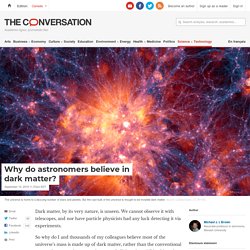
We cannot observe it with telescopes, and nor have particle physicists had any luck detecting it via experiments. So why do I and thousands of my colleagues believe most of the universe’s mass is made up of dark matter, rather than the conventional matter that comprises stars, planets, and all the other visible objects in our skies? To answer that question you need to appreciate what dark matter can and cannot do, understand where in the universe it lurks, and realise that “dark” is just the start of the puzzle.
Giant Radio Telescope in China Just Detected Repeating Signals From Across Space. Remember the spectacle of that gigantic telescope unveiled in a mountain-ringed valley in China just a few years ago?
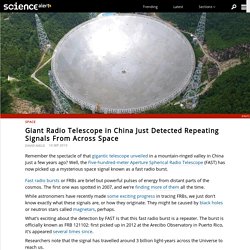
Well, the Five-hundred-meter Aperture Spherical Radio Telescope (FAST) has now picked up a mysterious space signal known as a fast radio burst. On Friday the 13th, a full 'harvest moon' will be visible in the night sky. A full “harvest moon” will be visible in the night sky this Friday the 13th and the following day, and though the timing sounds a bit ominous, there’s no reason to be spooked by this skywatching event.

This full moon is a so-called mini moon because it occurs when the moon is at its most distant point in its elliptical orbit around Earth, a point some 252,000 miles away that astronomers call lunar apogee. When the opposite occurs — when the moon turns full at its nearest point to Earth, called lunar perigee — it becomes a supermoon. Though mini moons — also known as micromoons — appear smaller and fainter than moons at other points in the lunar cycle, the differences are usually too subtle to be noticed with the naked eye. “It will look a bit smaller and about 13 percent fainter than average, but it’s not a huge effect,” said Patrick Hartigan, an astrophysicist at Rice University in Houston.
Water found in habitable super-Earth's atmosphere for first time. Astronomers have finally uncovered water vapor in the atmosphere of a super-Earth exoplanet orbiting within the habitable zone of its star.

The find means that liquid water could also exist on the rocky world's surface, potentially even forming a global ocean. The discovery, made with NASA's Hubble Space Telescope, serves as the first detection of water vapor in the atmosphere of such a planet. And because the planet, dubbed K2-18 b, likely sports a temperature similar to Earth, the newfound water vapor makes the world one of the most promising candidates for follow-up studies with next-generation space telescopes. "This is the only planet right now that we know outside the solar system that has the correct temperature to support water, it has an atmosphere, and it has water in it, making this planet the best candidate for habitability that we know right now," lead author Angelos Tsiaras, an astronomer at University College London, said in a press conference.
K2-18 b: The basics. Hubble Captures Deepest Optical Image of First Neutron Star Collision. An artistic rendition of two neutron stars merging.
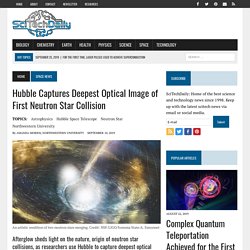
Credit: NSF/LIGO/Sonoma State/A. Simonnet. Astronomers Have Detected What Could Be The Most Massive Neutron Star Yet. Astronomers have identified what could be the most massive neutron star to date.
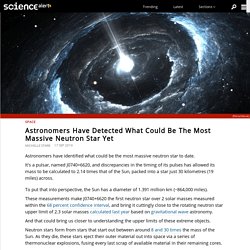
It's a pulsar, named J0740+6620, and discrepancies in the timing of its pulses has allowed its mass to be calculated to 2.14 times that of the Sun, packed into a star just 30 kilometres (19 miles) across. To put that into perspective, the Sun has a diameter of 1.391 million km (~864,000 miles). These measurements make J0740+6620 the first neutron star over 2 solar masses measured within the 68 percent confidence interval, and bring it cuttingly close to the rotating neutron star upper limit of 2.3 solar masses calculated last year based on gravitational wave astronomy. And that could bring us closer to understanding the upper limits of these extreme objects. Neutron stars form from stars that start out between around 8 and 30 times the mass of the Sun. This is similar to the process that produces a black hole, which occurs with more massive objects; however, no black hole has been detected below 5 solar masses.
Age of Saturn's rings debated as questions about life emerge. Saturn's rings may be shining as bright as ever, but the debate over how old they are has rekindled following a new study.
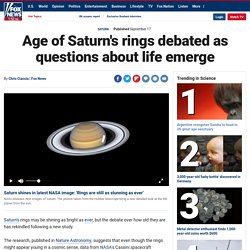
The research, published in Nature Astronomy, suggests that even though the rings might appear young in a cosmic sense, data from NASA's Cassini spacecraft shows that they are in fact nearly as old as the universe itself. "Spectacular results from Cassini’s Grand Finale have provided constraints on the characteristics and evolutionary processes of Saturn’s rings," the study's abstract states. "These results have been interpreted as proof that the rings are much younger than the Solar System, dramatically changing our view of the origin of the whole Saturnian system and attracting the attention of scientific media outlets. " Not Only Didn't We Find Water On An Earth-Like Exoplanet, But We Can't With Current Technology. This artist’s impression shows the planet K2-18b, its host star and an accompanying planet in this system.
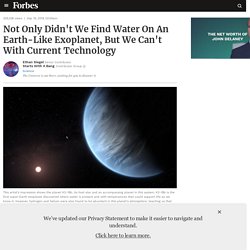
K2-18b is the first super-Earth exoplanet discovered where water is present and with temperatures that could support life as we know it. Blackest Black Ever Created by MIT Scientists, Captures Over 99.99 Percent of Light. Scientists from Massachusetts Institute of Technology (MIT) have unveiled the blackest black ever produced at an art exhibition in New York. The material, which is 10 times blacker than anything ever before reported, is made from carbon nanotubes (CNTs) and cuts out over 99.99 percent of light. This feat was achieved by accident—the team of engineers had been experimenting with different ways to create CNTs.
These are extremely thin tubes of carbon that are strong and excellent conductors of heat and electricity—properties that make them of great interest to scientists. Brian Wardle's team at MIT had been trying to grow CNTs on aluminium when they reached a hurdle. They found that a layer of oxide would coat the aluminium as soon as it was exposed to air—and this layer stopped it from conducting heat and electricity. Milky Way’s supermassive black hole reached record brightness in 2019. For the Milky Way’s supermassive black hole, it’s glow time. Known as Sagittarius A*, the behemoth at the center of the galaxy dazzled astronomers in 2019 with a light show more brilliant than ever recorded before. When observed in near-infrared wavelengths of light on May 13, the black hole was about twice as bright as the previous brightest observation seen in over 20 years of monitoring, astronomer Tuan Do and colleagues report September 11 in the Astrophysical Journal Letters.
Gas and dust heat up and produce light on their way into the black hole. Research reveals vital clues about recycling in the evolution of life in our universe. New research by Kent astrophysicists reveals vital clues about the role recycling plays in the formation of life in our universe. By investigating the different stages in the life journey of stars and gaining new knowledge about their evolutionary cycle, scientists at the Centre for Astrophysics and Planetary Science have discovered more about a crucial stage in the emergence of life in our universe. Their research reveals for the first time how matter discarded as stars die is recycled to form new stars and planets. Scientists have long known that the materials that make up human life were not present during the beginnings of the universe. Elements such as carbon and oxygen form deep inside stars and are released when the stars explode.
What has not been clear is what happens to these materials in the vast majority of stars which do not explode and how they are then extracted to contribute to the development of new planets and biospheres. "The shells are not uniform. Why Is It So Hard to Land on the Moon? Editor's Note: This story was updated at 12:30 p.m. E.D.T. on Monday, Sept. 16 Space is hard. That was the takeaway on Sept. 7, when the Indian Space Research Organisation (ISRO) lost contact with its Vikram lunar lander during an attempt to touch down at the moon's south pole. India was poised to become the fourth nation to ever successfully touch down softly on the lunar regolith, doing so in a place that no other country has previously reached. Astronomers Discover Most Massive Neutron Star Ever. Astronomers have discovered the most massive neutron star to date. Dubbed J0740+6620, the rapidly spinning pulsar packs 2.17 times the mass of our Sun (330,000 times that of Earth) into a sphere only about 15 miles across.
That’s darn near the limit of how massive and compact a single object can become without crushing itself into a black hole, according to West Virginia University, which assisted in the observation. Magnetic Field on Mars Mysteriously Pulses at Night, NASA's InSight Lander Finds. Hubble takes closer look at not-so-'dead' neighbor. Magnetic Field on Mars Mysteriously Pulses at Night, NASA's InSight Lander Finds.
Something is 'killing' galaxies in the most extreme parts of universe leaving scientists baffled. Is The Universe Filled With Black Holes That Shouldn't Exist? As viewed with our most powerful telescopes, such as Hubble, advances in camera technology and imaging techniques have enabled us to better probe and understand the physics and properties of distant quasars, including their central black hole properties. Venus Could Have Supported Life for Billions of Years. In 1978, NASA’s Pioneer Venus (aka. Pioneer 12) mission reached Venus (“Earth’s Sister”) and found indications that Venus may have once had oceans on its surface. Since then, several missions have been sent to Venus and gathered data on its surface and atmosphere.
Theory proposes that LIGO/Virgo black holes originate from a first order phase transition. If You Existed in Multiple Universes, How Would You Act In This One? In the course of a long life, each of us will occasionally encounter a difficult decision we must make. Stay single or get married? Go for a run or have another doughnut? Asteroid warning: ‘Hazardous’ asteroid twice the size of a bus to pass this week.
Black hole breakthrough: Einstein theory tabled after scientist claims light CAN escape. Black holes are regions of spacetime that form when massive stars collapse at the end of their life cycles. Dangerous Asteroids May Be Lurking in Jupiter's Shadow. One of the Fastest-Spinning Stars in the Galaxy Is Spitting Out Gamma Rays. Mysterious, second interstellar object ever spotted is confirmed. Space travel across the universe could be faster than speed of light with Warp Drive.
Black hole seeds missing in cosmic garden. Venus was likely habitable for 3B years. Then something mysterious happened. Huge CERN Experiment Detects Two Extremely Rare Particle Decay Events. Stunning New Black Hole Visualization From NASA Illustrates How Its Gravity Distorts Our View. Newfound Cosmic 'Gateway' Funnels Small, Icy Objects to the Inner Solar System. Better than earth? Are there superhabitable worlds in the Milky Way?
Astronomers Detect Gamma Rays From an Extreme Pulsar Spinning 707 Times Per Second. Dark matter mystery: CERN results hint at ‘evidence of new physics’ Black hole breakthrough: Einstein theory tabled after scientist claims light CAN escape. Mysterious Bubbles Discovered at Milky Way's Center. Rare Discovery! 3 Monster Black Holes Are About to Collide. One of the Fastest-Spinning Stars in the Galaxy Is Spitting Out Gamma Rays. 3 monster black holes are going to collide. NASA Wants You to Know That Black Holes Are Even Crazier When Viewed from the Side. A different kind of gravitational wave detector. Astrophysicists: gamma-ray jets exceed the speed of light. Asteroid alert: NASA just tracked a 9,200mph asteroid scrape past Earth. Giant planet around tiny star 'should not exist'
Astronomers Just Watched a Black Hole Shred a Star. 'Oumuamua and Borisov Are Just the Beginning of an Interstellar Object Bonanza. Hubble Tracks a Galaxy Moving Toward Us at Over 543,000 Miles Per Hour. NASA’s TESS Mission camera captures black hole tearing apart a star. 3 monster black holes are going to collide. Astronomers Have Found Another 21 Stars Dimming as Erratically as Tabby's Star. Astrophysicists: gamma-ray jets exceed the speed of light. India's Lost Moon Lander Is Somewhere in This NASA Photo. Mysterious planet so massive 'it should not exist' found by baffled astronomers in nearby star system. Astrophysicists: There May Be Black Holes Orbiting Our Sun. High-speed microscope illuminates biology at the speed of life. MAGIS-100: Atoms in free fall to probe dark matter, gravity and quantum science. Mysterious planet so massive 'it should not exist' found by baffled astronomers in nearby star system.
Asteroid news: ‘Potentially hazardous’ asteroid to fly closer to Earth than Moon this week. A metronome for quantum particles. Faster-Than-Light Speeds Could Be Why Gamma-Ray Bursts Seem to Go Backwards in Time. First alien gases detected from interstellar comet. Danger: Move to Mars before it's too late, warns space expert - Earth's in danger. 'Trainwreck' Crash of 3 Monster Black Holes Would Warp Their Host Galaxies. Snakes and Stones. Record Breaking Observations Link Dark Matter to Galaxy Formation. Suggests 'quantum foam' may explain away huge cosmic energy.
-starship-reach-orbit-six-months. How long will the Hubble Space Telescope last? Mars Is Heaven! Scientists Trace Supermassive Black Hole and Galaxy Co-Evolution in Romulus Simulation [Video] Mysterious 'Planet 9' Hiding in Our Solar System May Be a Grapefruit-Size Black Hole. The Four Fundamental Forces of Nature. Life on Mars? Researcher wants microbes in space to help humans survive 'barren sterile planets' A Red Dwarf Star Has a Jupiter-Like Planet. So Massive it Shouldn't Exist, and Yet, There It Is. Mars Is Heaven! Danger: Move to Mars before it's too late, warns space expert - Earth's in danger.
Astronomers Just Found the Oldest Galaxies in the Universe. First alien gases detected from interstellar comet. Astronomers spy cosmic bubbles and bow shocks. This Is China's New Spacecraft to Take Astronauts to the Moon (Photos) Black Holes As We Know Them May Not Exist. What If Planet 9 Is Actually a Tiny Black Hole? How long will the Hubble Space Telescope last? Astronomers spy cosmic bubbles and bow shocks. Three Supermassive Black Holes on Extremely Rare Collision Course [Video] Record Breaking Observations Link Dark Matter to Galaxy Formation. Did a large meteorite hit the earth 12,800 years ago? Here's new evidence. A Red Dwarf Star Has a Jupiter-Like Planet. So Massive it Shouldn't Exist, and Yet, There It Is. Asteroid news: Space rock to fly closer to Earth than Moon is this week. An Interstellar Comet, in Time for the Holidays. Astronomers Discover Massive Galaxy Surrounded by an Unexpected Halo of Tranquil Gas.
Elon Musk's Starship may be more moral catastrophe than bold step in space exploration. Five things we learned from Elon Musk's rollout of the SpaceX Starship prototype. Near-impossibly massive neutron star detected. No one agrees what it means for a planet to be “habitable” The Andromeda Galaxy Has Been Devouring Other Galaxies Since It Was a Baby (And Earth Is Next)